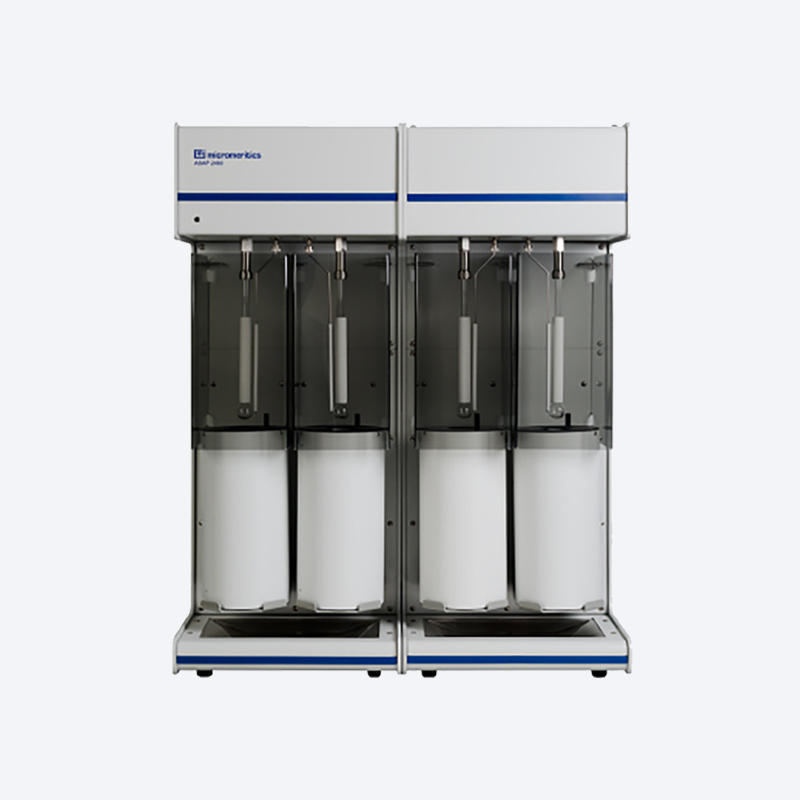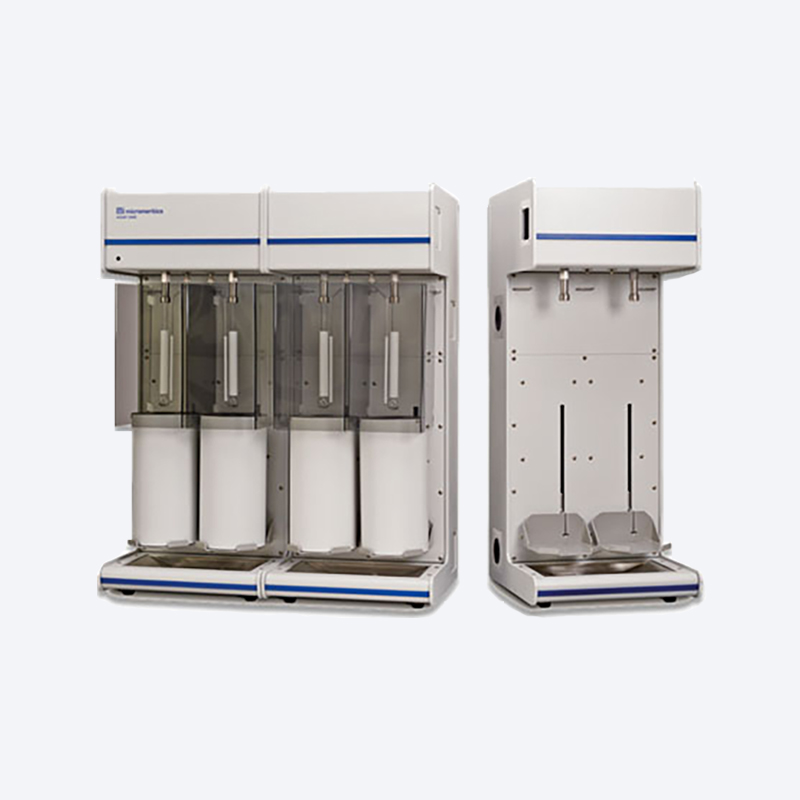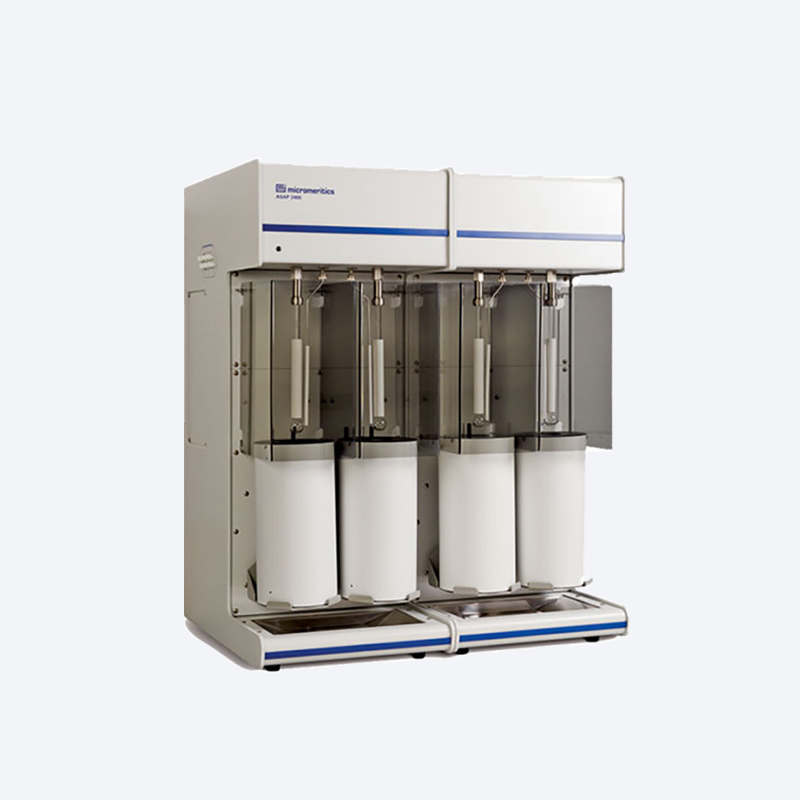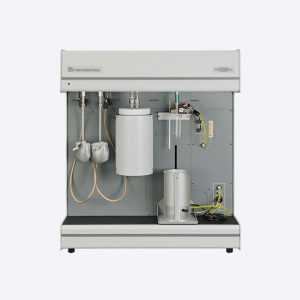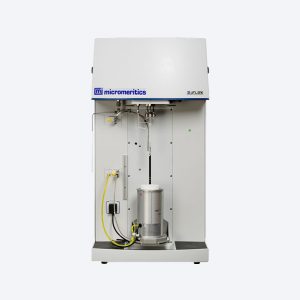Description
Analytical Versatility with Superior Throughput
All analysis ports can be operated independently and concurrently, allowing the user to load and unload samples at any time, regardless of the analysis stage.
An analysis in excess of 60 hours can be performed without refilling the dewar.
With a master unit and two auxiliary units, BET surface area analyses utilizing six parallel runs can be achieved in as little as 30 minutes.
Servo control for dosing and evacuation provides a higher degree of gas management and speeds collection of data points through reduction of dosing overshoot.
Up to five different non-reactive adsorptives, plus helium for free space, can be attached to the analyzer simultaneously.
Long-duration dewars and isothermal jackets assure a stable thermal profile along the length of both the sample and saturation pressure (P0) tubes throughout lengthy analyses.
Intuitive MicroActive software combines user defined reports with the ability to interactively evaluate isotherm data.
User selectable data ranges through the graphic interface allow direct modeling for BET, t-plot, Langmuir, DFT interpretation, and new advanced NLDFT methods.
Link to ASAP 2460 Data Presentation
An innovative dashboard monitors and provides convenient access to real-time instrument performance indicators and maintenance scheduling.
Benefits
- Fully automated modular system optimized for walk-up sample screening
- High throughput with two, four, or six independent analysis stations
- BET surface area measurements in as little as 30 minutes
- Dosing options of maximum volume increment or dosing over specified pressure ranges
- Analysis temperature can be entered, calculated, or measured
- Equilibration option allows user to specify equilibration times for different parts of the isotherm
- Low surface area and micropore options
- Innovative MicroActive software with advanced NLDFT modeling
Low Surface Area Measurement (Krypton) and Dedicated Micropore Options
In addition to the standard 2460, low surface area krypton and micropore models are available. Low surface area (Krypton) model includes the addition of a 10-mm Hg transducer and permits accurate measurement of very low surface area on materials such as API (active pharmaceutical ingredient), powdered metals, etc.
The micropore model includes the addition of a 1-mm Hg transducer which extends the low pressure measurement capabilities and allows enhanced performance for characterizing microporous materials using nitrogen, argon, carbon dioxide, hydrogen, and other fixed gases. The transducer also increases pressure resolution in the range necessary for micropore analysis.
Typical Applications
Pharmaceuticals:
- Surface area and porosity play major roles in the purification, processing, blending, tableting, and packaging of pharmaceutical products.
Ceramics:
- Surface area and porosity affect the curing and bonding of greenware and influence strength, texture, appearance, and density of finished goods.
Adsorbents:
- Knowledge of surface area, total pore volume, and pore size distribution is important for quality control of industrial adsorbents and in the development of separation processes.
Activated Carbons:
- Surface area and porosity must be optimized within narrow ranges to accomplish gasoline vapor recovery in automobiles, solvent recovery in painting operations, or pollution controls in wastewater management.
Carbon Black:
- The wear lifetime, traction, and performance of tires are related to the surface area of carbon blacks used in their production.
Fuel Cells:
- Fuel cell electrodes require high surface area with controlled porosity to produce optimum power density.
Catalysts:
- The active surface area and pore structure of catalysts influence production rates. Limiting the pore size allows only molecules of desired sizes to enter and exit.
Paints and Coatings:
- The surface area of a pigment or filler influences the gloss, texture, color, color saturation, brightness,solids content, and film adhesion properties.
Projectile Propellant:
- The burn rate of propellants is a function of surface area too high a rate can be dangerous; too low a rate can cause malfunction and inaccuracy.
Medical Implants:
- Controlling the porosity of artificial bone allows it to imitate real bone that the body will accept and allow tissue to be grown around it.
Electronics:
- By selecting high surface area material with carefully designed pore networks, manufacturers of super-capacitors can minimize the use of costly raw materials while providing more exposed surface area for storage of charge.
Cosmetics:
- Surface area is often used by cosmetic manufacturers as a predictor of particle size when agglomeration tendencies of the fine powders make analysis with a particle-sizing instrument difficult.
Aerospace:
- Surface area and porosity of heat shields and insulating materials affect weight and function.
Geoscience:
- Porosity is important in groundwater hydrology and petroleum exploration because it relates to the quantity of fluid that a structure can contain.
Nanotubes:
- Nanotube surface area and microporosity are used to predict the capacity of a material to store hydrogen.
Instrument Overview
Innovative MicroActive Software:
- Micromeritics’ innovative MicroActive software allows users to interactively evaluate isotherm data from Micromeritics ASAP, TriStar, and Gemini gas adsorption instruments.
- Users can easily include or exclude data, fitting the desired range of experimentally acquired data points using interactive, movable calculation bars. Isotherms can be viewed on either a linear or logarithmic scale, available to the user under each calculation model. No need to generate reports to review results.
Data Reduction Benefits:
- Interaction with adsorption data is direct. By simply moving the calculation bars, the user is immediately updated with new textual properties.
- Interactive data manipulation minimizes the use of dialog boxes and tunneling of dialogs to specify calculation parameters.
- Improved ability to overlay files (up to 25) including mercury intrusion data with single-click file add and subtract feature.
- User selectable data ranges through the graphic interface allow direct modeling for BET, t-plot, Langmuir, DFT interpretation, and much more.
- Report Options editor allows the user to define up to five reports with on-screen previews. Each report has the ability to possess one summary, tabular, and graphical information pane.
Calculations, such as the BET surface area transform plot, can be easily generated and adjusted. The selection bars allow for a range of data points to be quickly and easily selected.
As a result, the summary of values derived from the calculations is instantly updated. Within the calculation window(s), the range of data used can be further refined.
The pressure table allows data points to be taken in small increments of pressure, quantity dosed, or both.
Method wizards:
- Both novice and experienced users can easily create methods. Methods corresponding to published ASTM test methods are included for various materials.
NLDFT Modeling
The NLDFT Advanced PSD, Dual DFT modeling allows the user to combine the information gathered from nitrogen and carbon dioxide isotherms to deliver a full pore size distribution on materials (such as carbon slit pores) where pores of molecular sizes are present.
The range of pore size analysis in this method is extended to smaller pore sizes compared to the standard nitrogen analysis. This is due to the fact that CO2 can access some very small micropores that are not accessible to N2 at cryogenic temperatures because of size restrictions.
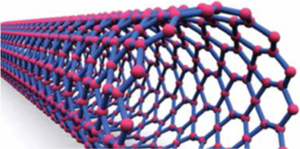
ASAP 2460 Interactive Reports include
- Isotherm
- BET Surface Area
- Langmuir Surface Area
- t-Plot
- Alpha-S Method
- BJH Adsorption and Desorption
- Dollimore-Heal Adsorption and Desorption
- Horvath-Kawazoe
- MP-Method
- DFT Pore Size and Surface Energy
- Dubinin-Radushkevich
- Dubinin-Astakhov
- Summary
- User-Defined Reports

